USS Enterprise (CVN-65)
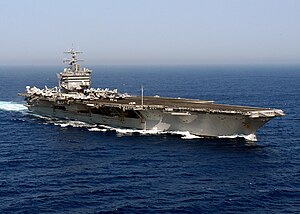 USS Enterprise underway in the Atlantic Ocean
| |
| Class overview | |
|---|---|
| Name | Enterprise-class aircraft carrier |
| Builders | Newport News Shipbuilding |
| Operators | |
| Preceded by | Kitty Hawk class |
| Succeeded by | Nimitz class |
| Built | 1958–1961 |
| In service |
|
| Planned | 6 |
| Completed | 1 |
| Cancelled | 5 |
| Retired | 1 |
| History | |
| Name | Enterprise |
| Namesake | USS Enterprise (CV-6) |
| Ordered | 15 November 1957 |
| Builder | Newport News Shipbuilding and Drydock Company |
| Cost | $451.3 million[1] |
| Laid down | 4 February 1958 |
| Launched | 24 September 1960 |
| Christened | 24 September 1960 |
| Acquired | 29 October 1961 |
| Commissioned | 25 November 1961 |
| Decommissioned | 3 February 2017 |
| In service | 12 January 1962 |
| Out of service | 1 December 2012 |
| Reclassified | CVN-65 from CVA(N)-65, 30 June 1975 |
| Refit | 27 September 1994 |
| Stricken | 3 February 2017 |
| Motto |
|
| Nickname(s) | Big E[2] |
| Status | Awaiting recycling at HII Shipyard, Newport News, Virginia |
| Badge |  |
| General characteristics | |
| Class and type | Enterprise-class aircraft carrier |
| Displacement | 93,284-long-ton (94,781 t) full load[3] |
| Length | |
| Beam |
|
| Draft | 39 ft (12 m) |
| Propulsion |
|
| Speed | 33.6 kn (38.7 mph; 62.2 km/h)[6] |
| Range | Unlimited distance; 20–25 years |
| Complement |
|
| Sensors and processing systems |
|
| Electronic warfare & decoys | |
| Armament |
|
| Armor | 8 in (20 cm) aluminum belt (equivalent to 4 in (10 cm) rolled homogeneous steel armor), armored flight deck, hangar, magazines and reactor[8][9] |
| Aircraft carried |
|
| Aviation facilities | Flight deck: 1,123 ft (342 m) |
| Notes | Equipped with 4 steam-powered catapults.[11] |
36°58′50″N 76°26′18″W / 36.9805°N 76.4384°W USS Enterprise (CVN-65), formerly CVA(N)-65, is a decommissioned[12] United States Navy aircraft carrier. In 1958, she became the first nuclear-powered aircraft carrier in the United States Navy, and the world, as well as the eighth United States naval vessel to bear the name. Like her predecessor of World War II fame, she is nicknamed "Big E". At 1,123 feet (342 m),[4][5] she is the longest naval vessel ever built and the only ship of a class that was originally planned to have five other ships. Her 93,284-long-ton (94,781 t)[3] displacement ranks her class as the third largest carrier class, after the Nimitz class and the Gerald R. Ford class. Enterprise had a crew of some 4,600 service members.[10]
Enterprise[13] was, at the time of inactivation, the third-oldest commissioned vessel in the United States Navy after the wooden-hulled USS Constitution and USS Pueblo.[14] She was inactivated on 1 December 2012,[15] and officially decommissioned on 3 February 2017,[16][17] after over 55 years of service.[18][19] She was stricken from the Naval Vessel Register the same day.[20] The name has been adopted by the future Gerald R. Ford-class aircraft carrier: USS Enterprise (CVN-80).[21][22]
Design
[edit]Designed under project SCB 160,[23] USS Enterprise was intended as the lead ship of a new class of six nuclear powered aircraft carriers, but massive increases in construction costs led to the remaining vessels being cancelled.
Enterprise is the only aircraft carrier to house more than two nuclear reactors,[4] having an eight-reactor propulsion design, with each A2W reactor taking the place of one of the conventional boilers in earlier constructions.[24] She is the only carrier with four rudders, two more than other classes, and features a more cruiser-like hull.[25]
Armament
[edit]Because of the huge cost of her construction, Enterprise was launched and commissioned without the planned RIM-2 Terrier missile launchers.[26] Initially, the carrier had little defensive armament.[23][27][a] Late in 1967, Enterprise was fitted with a prototype Basic Point Defense Missile System (BPDMS) installation, with two eight-round box launchers for Sea Sparrow missiles.[23][29] A third BPDMS launcher was fitted during the ship's refit in 1970–1971.[30]
Later upgrades added two NATO Sea Sparrow (NSSM) and three Mk 15 Phalanx CIWS gun mounts.[31] One CIWS mount was later removed and two 21-cell RIM-116 Rolling Airframe Missile launchers were added.[32][33]
Radar
[edit]Enterprise had a phased array radar system known as SCANFAR. SCANFAR was intended to be better at tracking multiple airborne targets than conventional rotating antenna radars. SCANFAR consisted of two radars, the AN/SPS-32 and the AN/SPS-33. The AN/SPS-32 was a long-range air search and target acquisition radar developed by Hughes for the US Navy. The AN/SPS-32 operated together with the AN/SPS-33, which was the square array used for 3D tracking, into one system. It was installed on only two vessels, Enterprise and the cruiser USS Long Beach, placing an unacceptable power drain on the electric systems of both ships.[citation needed]
The technology of the AN/SPS-32 was based on vacuum tubes and the system required constant repairs. The SPS-32 was a phased array radar which had a range of 400 nautical miles against large targets, and 200 nautical miles against small, fighter-size targets.[34] These early phased arrays, replaced around 1980, were responsible for the distinctive square-looking island.[11]
The AN/SPS-32 and AN/SPS-33 radars, while ahead of their time, suffered from issues relating to the electrical beam steering mechanism and were not pursued in further ship classes. While they are considered to be an early form of "phased array" radar, it would take the later technology of the Aegis phased array AN/SPY-1 with its electronically controlled beam steering to make phased array radars both reliable and practical for the USN.[35] The dome above the SCANFAR contained the unique electronic warfare suite, the Andrew Alford AA-8200 dipole antennas (which never acquired a military designation). The system consisted of six rows of antennae encircling the dome. The antennas in the upper two rows were encased in piping radomes as they were small and fragile.
History
[edit]Commissioning and trials
[edit]The ship's keel was laid at Newport News Shipbuilding and Drydock Company in Shipway 11 on 4 February 1958. On 24 September 1960, the ship was launched, sponsored by the wife of William B. Franke, then Secretary of the Navy. On 25 November 1961, Enterprise was officially commissioned, with Captain Vincent P. de Poix, formerly of Fighting Squadron 6 on her predecessor,[36] in command. On 12 January 1962, the ship made her maiden voyage starting an extensive shakedown cruise and a lengthy series of tests and training exercises designed to determine the full capabilities of the nuclear powered super carrier.[37] A full-speed run with her escort, USS Laffey (DD-724), demonstrated the sheer power and speed of Enterprise's novel nuclear propulsion plant; afterwards, Laffey radioed, "You win the race. Fuel gone, topside salted, crew wet, and engines tired."[38] On 20 February 1962, Enterprise was a tracking and measuring station for the flight of Friendship 7, the Project Mercury space capsule in which Lieutenant Colonel John H. Glenn Jr. made the first American orbital spaceflight.[39] Enterprise completed shakedown activities at Naval Station Norfolk on 5 April 1962.[37]
 |
 USS Enterprise, official postmark and cachet mailed during Guantanamo (GITMO) Shake Down Cruise 10 February 1962 |
1960s
[edit]On 25 June 1962, Enterprise joined the 2nd Fleet on her initial operational deployment, carrying out training off the US East Coast, and took part in Exercise LantFlex 2-62, a nuclear strike exercise, in conjunction with the carrier Forrestal from 6–12 July.[40][39] In August, the carrier joined the 6th Fleet in the Mediterranean Sea, returning to Norfolk, Virginia on 11 October 1962.[40]
1962 Cuban Missile Crisis
[edit]In October 1962, Enterprise was dispatched to her first international crisis. Following revelations that the Soviet Union was constructing nuclear missile launch sites on Cuba, President John F. Kennedy ordered the United States Department of Defense to conduct a large-scale buildup. Among the preparations, the US Atlantic Fleet readied large numbers of its ships. On 22 October, President Kennedy ordered a naval and air "quarantine" (blockade) on shipment of offensive military equipment to Cuba and demanded the Soviets dismantle the missile sites there. Five Second Fleet carriers participated in the blockade—Enterprise (as part of Task Force 135), Independence, Essex, Lake Champlain, and Randolph, backed by shore-based aircraft. By 28 October, the crisis was both peacefully and successfully averted, after the United States secretly agreed to remove nuclear missiles from Italy and Turkey.[41]
Second and third deployments
[edit]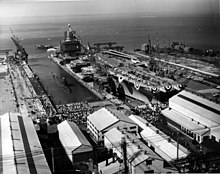 |
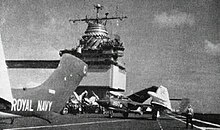 |
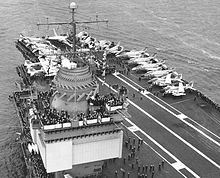 |
 |
On 19 December 1962, a Grumman E-2 Hawkeye was catapulted off Enterprise in the first shipboard test of a nose-wheel launch bar designed to replace the catapult bridle.[42] Minutes later, a second launch with a launch bar was made by a Grumman A-6A Intruder, demonstrating one of the primary design goals of reducing launch intervals.[43]
In 1963–1964, now under command of Captain Frederick H. Michaelis, Enterprise made her second and third deployments to the Mediterranean. During her third deployment, the carrier was part of Operation Sea Orbit, the world's first nuclear-powered task force with the cruisers Long Beach and Bainbridge, together forming a convoy to sail around the world. On 25 February 1964, a crewman of the Finnish merchant ship Verna Paulin was injured in a fall while the ship was in the vicinity of Souda Bay, Greece. Enterprise answered her call for assistance. A surgeon was transferred to Verna Paulin by helicopter.[39] In October 1964, Enterprise returned to Newport News Shipbuilding and Dry Dock Company for her first Refueling and Overhaul. During this refit, her eight nuclear reactors, which had powered Enterprise as she steamed over 200,000 nmi (230,000 mi; 370,000 km), were refueled, two of her propeller shafts were replaced, and the ship's electronics were updated. Enterprise emerged from her refit on 22 June 1965 and returned to action.[44]
Vietnam deployments
[edit]In November 1965, the Enterprise was transferred to the Seventh Fleet, home-ported at NAS Alameda, California. The following month, on 2 December, she became the first nuclear-powered ship to engage in combat when she launched aircraft against the Viet Cong near Biên Hòa City. The ship led Carrier Division Three, with Enterprise (redesignated CVA(N)-65), which had Carrier Air Wing Nine (CVW-9) aboard, Bainbridge; Barry; and Samuel B. Roberts. Enterprise launched 125 sorties on the first day, unleashing 167 short tons (151 t) of bombs and rockets on the enemy's supply lines. On 3 December, she set a record of 165 strike sorties in a single day.[45]
In January 1966, the aircraft carrier was continuing operations as a unit of Task Force 77 in the Gulf of Tonkin, as the flagship of Rear Admiral Henry L. Miller, Commander Carrier Division Three.[46] Under the command of Captain James L. Holloway III, she was carrying a complement of approximately 350 officers and 4,800 men. Four West coast squadrons of CVW-9, commanded by Commander F. T. Brown, were embarked; VF-92, under Commander E. A. Rawsthorne, and VF-96, under Commander R. D. Norman, flying F-4B Phantom IIs; VA-93 under Commander A. J. Monger, and VA-94, under Commander O. E. Krueger, flying A-4C Skyhawks. With these squadrons were three others based on the East Coast; VA-36, under Commander J. E. Marshall, VA-76, under Commander J. B. Linder, flying A-4C Skyhawks; and RVAH-7, under Commander K. Enny, flying RA-5C Vigilantes. Rear Admiral Miller was relieved as Commander Carrier Division Three by Rear Admiral T. J. Walker on 16 February 1966. During the change of command ceremony on the flight deck, Rear Admiral Miller praised the ship's performance in his farewell remarks and presented air medals to more than 100 pilots and flight officers.[47]
The ship tied up at Leyte Pier, U.S. Naval Base Subic Bay, on the evening of 8 December 1966.[46] Loading of supplies for the first line period was started immediately. Rear Admiral Walter L Curtis Jr, Commander Carrier Division Nine, brought his flag aboard. In company with Manley, Gridley and Bainbridge, Enterprise sailed for Yankee Station on 15 December, and took up her position there three days later.[citation needed]
When Enterprise departed the Gulf of Tonkin on 20 June 1967, her pilots had flown more than 13,400 battle missions during 132 combat days of operations. (Enterprise Command History 1967, 29) As Vice Admiral Hyland stated in his congratulatory statement, "the entire Air Wing Nine has earned a resounding 'Well Done'." The carrier had steamed 67,630 miles in operations with the Seventh Fleet. She arrived in Subic Bay on 22 June and departed on 25 June for return to Alameda on 6 July 1967.[citation needed]

At Alameda, Enterprise began an overhaul. Captain Kent Lee relieved Captain James L. Holloway as commanding officer in ceremonies on 11 July 1967. Shipyard work was completed on 5 September 1967, and after completing sea trials on 7 September, Enterprise steamed south from San Francisco Bay to San Diego to reembark CVW-9 and get underway for refresher training off the California coast.[citation needed]
Enterprise was visiting Sasebo, Japan in January 1968 when the US intelligence ship USS Pueblo was seized by North Korea, and she served as flagship of TF 71 (Rear Admiral Epes), which had been formed in response and they operated near South Korean waters for almost a month, during Operation Formation Star. When diplomatic negotiations had defused tensions, Enterprise and her escorts were released to head south to Yankee Station on 16 February 1968. Enterprise returned to NAS Alameda on 18 July 1968, having completed 12,839 catapult launches, with 12,246 sorties – 9,182 of them combat. After a short overhaul in Puget Sound Naval Shipyard from 29 July to 26 September, she returned to Alameda to prepare for another deployment to Vietnam.[citation needed]
1969 fire
[edit]
During the morning of 14 January 1969, while being escorted by the destroyers Benjamin Stoddert and Rogers, a MK-32 Zuni rocket loaded on a parked F-4 Phantom exploded when ordnance cooked off after being overheated by an aircraft start unit.[48] The explosion set off fires and additional explosions across the flight deck.[citation needed]
The fires were brought under control relatively quickly (when compared with previous carrier flight deck fires), but 27 sailors were killed, and an additional 314 sailors were injured. The fire destroyed 15 aircraft, and the resulting damage forced Enterprise to put in for repairs at Pearl Harbor Naval Shipyard, Hawaii, primarily to repair the flight deck's armored plating.[49] On 1 March 1969, repairs to the ship were completed and the ship proceeded on her scheduled western Pacific (WESTPAC) deployment to Vietnam and the Tonkin Gulf. These destinations would be delayed by events in the eastern Sea of Japan.[50]
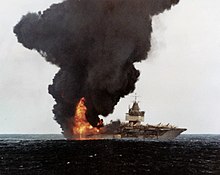
Korean operations
[edit]On 14 April 1969, tensions with North Korea flared again as a North Korean aircraft shot down a Lockheed EC-121 Warning Star that was on a reconnaissance patrol over the eastern Sea of Japan from its base at Atsugi, Japan. The entire 31-man crew was killed. The US responded by activating Task Force 71 (TF 71) to protect future such flights over those international waters. Initially, the Task Force was to comprise Enterprise, Ticonderoga, Ranger, and Hornet with a screen of cruisers and destroyers. Enterprise arrived on station with TF 71 in late April after completion of repairs. The ships for TF 71 came mostly from Southeast Asia duty. This deployment became one of the largest shows of force in the area since the Korean War.[citation needed]
1970s
[edit]In 1969–1970, Enterprise returned to Newport News Shipbuilding and went through an overhaul and her second refitting. In January 1971, she completed sea trials with newly designed nuclear reactor cores that contained enough energy for 10 years. On 11 June 1971 Enterprise, with Captain Forrest S. Petersen now in command and Carrier Air Wing Fourteen (CVW-14) onboard, then departed for Vietnam again.[51]: 423
South and Southeast Asia
[edit]
Enterprise, Oriskany and Midway launched a total of 2,001 strike sorties by 30 July 1971. Strike operations in July were disrupted when the carriers on station evaded three typhoons: Harriet, Kim and Jean. A slight increase in South Vietnam strike sorties occurred during the month. These were mainly visual strikes against enemy troop positions and in support of U.S. helicopter operations. From August–November 1971, Enterprise was in operations on Yankee Station.[51]: 423
In December 1971, Captain Ernest E. Tissot Jr. assumed command, and Enterprise was deployed to the Bay of Bengal, during the Indo-Pakistani War of 1971 as a show of strength against India's naval blockade by INS Vikrant. Later a Soviet Navy submarine was also trailing the US task force. A confrontation was averted when Enterprise moved away from the Indian Ocean toward Southeast Asia.[52] Enterprise completed its deployment on 12 February 1972.[51]: 423
Enterprise returned to the South China Sea from 12 September 1972 with CVW-14 onboard.[51]: 424 On 18 December 1972, the United States resumed bombing campaigns above the 20th parallel under the name Linebacker II. During Linebacker II operations, Enterprise and other carriers on station reseeded the mine fields in Haiphong harbor and conducted concentrated strikes against surface-to-air missile and anti-aircraft artillery sites, enemy army barracks, petroleum storage areas, Haiphong naval and shipyard areas, and railroad and truck stations. Navy tactical air attack sorties under Linebacker II were centered in the coastal areas around Hanoi and Haiphong. There were 705 Navy sorties in this area during Linebacker II. Between 18 and 22 December, the Navy conducted 119 Linebacker II strikes in North Vietnam, with the main limiting factor on airstrikes being bad weather.[citation needed] In December 1972, the North Vietnamese returned to the peace table and Linebacker II ended. In January 1973, the Vietnam cease-fire was announced, and American carriers ceased all combat sorties into North and South Vietnam.[citation needed] From 28 January 1973, aircraft from Enterprise and Ranger flew 81 combat sorties against lines-of-communication targets in Laos. The corridor for overflights was between Huế and Da Nang in South Vietnam. These combat support sorties were flown in support of the Laotian government, which had requested this assistance. Laos had no relationship with the ceasefire in Vietnam.[citation needed] Enterprise completed its deployment on 12 June 1973.[51]: 424
Post-Vietnam
[edit]After the cease-fire in Vietnam in 1973, Enterprise proceeded to the Puget Sound Naval Shipyard, Bremerton, Washington, where the carrier was altered and refitted to support the Navy's newest fighter aircraft – the Grumman F-14 Tomcat. Two of four jet blast deflectors were enlarged to accommodate the Tomcat. The No. 4 propulsion shaft was replaced; it had been bent when its screw became fouled in a discarded arresting gear cable.[citation needed]
On 18 March 1974, the first operational Tomcats of VF-1 Wolfpack and VF-2 Bounty Hunters made their maiden takeoffs and landings from the carrier. In September 1974, Enterprise became the first carrier to deploy with the new fighter plane when she made her seventh WESTPAC deployment.[51]: 426
In February 1975, Typhoon Gervaise struck the island nation of Mauritius, and Enterprise was ordered to provide disaster relief. Arriving at Port Louis, carrier personnel spent more than 10,000 man-hours rendering such assistance as restoring water, power and telephone systems, clearing roads and debris, and providing helicopter, medical, food and drinkable water support to the stricken area.[citation needed]
Operation Frequent Wind
[edit]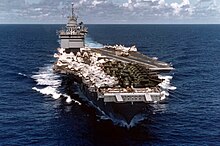
In April 1975, Enterprise, Midway, Coral Sea, Hancock and Okinawa were deployed to waters off South Vietnam for possible evacuation contingencies as North Vietnam, in violation of the Paris Peace Accords, launched a conventional invasion of South Vietnam. On 29 April, Operation Frequent Wind was carried out by U.S. Navy and U.S. Marine Corps helicopters from the 7th Fleet. The Operation involved the evacuation of American citizens and "at-risk" Vietnamese from Saigon, the capital of South Vietnam under heavy attack from the invading forces of North Vietnam.[53]
President Gerald Ford ordered helicopter evacuation when PAVN shelling forced the cessation of fixed-wing evacuation from Tan Son Nhut Airport. With fighter cover provided by carrier aircraft, the helicopters landed at the US Embassy, Saigon and the DAO Compound to pick up evacuees. The last helicopter lifted off the roof of the United States Embassy at 7:53 am, local time, on 30 April 1975 carrying the last 11 Marine Security Guards. During Operation Frequent Wind, aircraft from Enterprise flew 95 sorties.[53] VF-1 and VF-2, flying from Enterprise made the first combat deployment of the F-14 Tomcat.[54]
Eighth and ninth deployments
[edit]In July 1976, Enterprise began her eighth Western Pacific deployment. Beginning in October she took part in the ANZUS exercise 'Kangaroo II' with ships of the Australian and New Zealand Navies.[55]
One of the ports visited was Hobart, Tasmania in November 1976. It had also been the first time an American ship anchored in the capital's harbor, Hobart, since the early 1920s. A beer with a picture of the Enterprise for its label was just one of the commemorations received by the renowned nuclear carrier.[citation needed]
In February 1977, Idi Amin, the President of Uganda, made derogatory remarks against the United States in public and Americans in Uganda were taken hostage. This was several months after the Israeli raid at Entebbe airport. Enterprise and her escort ships were scheduled to transit home after a seven-month deployment but having just left Mombasa after a port call, were directed to remain in the area and operated off the east African coast for about one week. The ship's Marine detachment and air wing prepared for a possible mission to rescue and evacuate the Americans, but Amin eventually released all the hostages. The ships then steamed across the Indian Ocean at high speed to make a previously scheduled final port call at NAS Cubi Point in the Philippines before returning to NAS Alameda.[citation needed]

In 1978, Enterprise underwent her ninth Western Pacific deployment, the last before the ship's planned major refit. The 1978 WESTPAC cruise included port calls in Hong Kong, Perth, Australia, and Singapore, and ended at the end of the year. In January 1979, the carrier arrived at Puget Sound Naval Shipyard for the intended 36-month refurbishment. This overhaul modified the ship's superstructure – removing the SCANFAR radars and the unique inverted cone-shaped top section, which was three stories high. During the lengthy overhaul, Navy and shipyard personnel referred to Enterprise as Building 65.[citation needed]
1980s
[edit]
In 1982, the carrier made her 10th WESTPAC deployment. In April 1983, Enterprise ran aground on a sandbar in San Francisco Bay while returning from deployment and remained stuck there for several hours.[56] Coincidentally, George Takei, who played Mr. Sulu, helmsman of the fictional starship Enterprise, was aboard at the time as a guest of the Navy.[57] Even though groundings and collisions are usually career-ending events for U.S. warship captains, the captain at the time, Robert J. Kelly, who had already been selected for promotion to commodore, eventually became a four-star admiral and Commander-in-Chief of the US Pacific Fleet.[58]

In 1985, the Enterprise began training for her 11th WESTPAC deployment. Late at night on 2 November 1985 with Captain Robert L. Leuschner Jr. on the bridge, she struck Bishop Rock on the Cortes Bank during flight exercises, damaging the outer hull with a gash more than 100 feet in length and knocking out of one screw, a chip whose size was illustrated with a photograph of a Navy diver stretched out and reclining inside the notch.[citation needed] The cost of repairing the damage was $17 million, and Leuschner was relieved of command on 27 January 1986 as a result of the incident, by Captain Robert J. Spane.[59]
In 1986, the carrier made her 12th WESTPAC deployment, leaving on 15 January 1986. She led Battle Group FOXTROT, including Truxtun, Arkansas, O'Brien, Reasoner, Lewis B. Puller, McClusky, David R. Ray and Wabash. The Battle Group sailed directly for the Indian Ocean, with stops in Hawaii, Subic Bay, and Singapore.[60] On 28 April 1986, Enterprise became the first nuclear-powered aircraft carrier to transit the Suez Canal. She went from the Red Sea to the Mediterranean to relieve Coral Sea, on station with America off the coast of Libya. Enterprise entered the Mediterranean to support "Operation El Dorado Canyon", the US bombing of Libya. It was the ship's first visit to the Mediterranean in more than 22 years. During the deployment, Rear Admiral J.T. Howe was relieved as Commander Cruiser-Destroyer Group 3 by Rear Admiral Paul David Miller.[61]
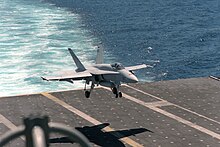
In February 1988, Enterprise underwent her 13th deployment and was assigned to Operation Earnest Will, escorting reflagged Kuwaiti oil tankers in the Persian Gulf. On 14 April, another Earnest Will ship, Samuel B. Roberts, struck an Iranian mine in international waters. In response, the US launched Operation Praying Mantis against Iranian targets, starting with two Iranian oil platforms that were being used as support bases for Iranian attacks on merchant shipping. Aircraft from Enterprise's CVW-11 bombed two Iranian frigates, helping to sink one and damaged the other, and provided other air support for the strike.[62]
In September 1989, Enterprise left Alameda and began her 14th overseas deployment, an around-the-world cruise that would end at the ship's new homeport of Naval Station Norfolk, Virginia. In early December 1989, Enterprise and Midway participated in Operation Classic Resolve, President George H. W. Bush's response to Philippine President Corazon Aquino's request for air support during the rebel coup attempt. Enterprise remained on station conducting flight operations in the waters outside Manila Bay until the situation subsided.[citation needed]
1990s
[edit]In April 1990, Enterprise completed her around-the-world deployment, arriving in Norfolk, Virginia, after having steamed more than 43,000 mi (69,000 km) (nautical). In October, the carrier moved to Newport News Shipbuilding for refueling and the Navy's largest complex overhaul refit ever attempted. On 27 September 1994, Enterprise returned to sea for sea trials, now with Captain Richard J. Naughton in command, during which she performed an extended full power run as fast as when she was new.[63]
On 28 June 1996, Enterprise began her 15th overseas deployment. The carrier enforced no-fly zones in Bosnia as part of Operation Joint Endeavor and over Iraq as part of Operation Southern Watch. The deployment ended in December 1996, which also marked the end of active service for the Grumman A-6 Intruder from the Navy. February 1997, Enterprise entered Newport News Shipbuilding for an extended selective restrictive availability lasting four-and-a-half months.[citation needed]

In November 1998, following workups, Enterprise departed on her 16th overseas deployment, with CVW-3 embarked. On the night of 8 November, shortly after the start of the deployment, a Northrop Grumman EA-6B Prowler crashed into a Lockheed S-3 Viking on the carrier's flight deck. The mishap occurred as the EA-6B was landing during night carrier qualifications, striking the folded wings of the S-3, which had not yet cleared the landing area of the flight deck.[64]
The four-man crew of the EA-6B perished when the aircraft hit the water, but the two crew members of the S-3 ejected. A fire broke out on the flight deck but was quickly extinguished by the flight deck crew.[65] Three of the four members of the Prowler crew were lost at sea, and the remains of the fourth were recovered shortly after the crash. The crew of the Viking were rushed to the Naval Medical Center Portsmouth, Virginia. There were no other significant injuries. An exhaustive search for three missing EA-6B Prowler crew members was suspended after nearly 24 hours.[66][67]
On 23 November 1998, Enterprise relieved Dwight D. Eisenhower in the Persian Gulf.
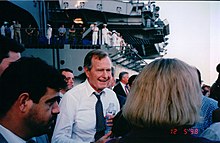

During a port call in Jebel Ali, UAE, the carrier hosted former President George H. W. Bush and enjoyed a live concert by rock group Hootie & the Blowfish.[68]
In December 1998, Enterprise battlegroup spearheaded Operation Desert Fox, destroying Iraqi military targets with more than 300 Tomahawk land attack missiles and 691,000 lb (346 short tons; 313 tonnes) of ordnance. The 70-hour assault was carried out by Enterprise, Gettysburg, Stout, Nicholson and Miami.[citation needed]
Shortly after the Račak massacre and failure of Yugoslavian peace talks in Rambouillet, France, Enterprise quickly left a port visit in Cannes, France, to return to the Adriatic.[citation needed]
In early March 1999, Enterprise returned to the Persian Gulf to relieve Carl Vinson in support of Operation Southern Watch, returning to Norfolk in May 1999.[citation needed]
During the 1998–1999 deployment, Enterprise steamed more than 50,000 nmi (93,000 km; 58,000 mi) and spent 151 days underway. Enterprise Battle Group was the first to deploy with IT-21, which allowed unprecedented internal and external communication capabilities, including Internet, email, and television.[citation needed]
2000s
[edit]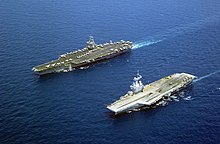
In March 2001, Enterprise took part in the exercise JTFEX 01-2 in the Caribbean Sea.[69] U24, a Type 206 class diesel-electric submarine with the German Navy, managed to "sink" the Enterprise by firing flares and taking a photograph through its periscope.[70]
On 25 April 2001, Enterprise began her 17th overseas deployment with CVW-8 embarked and Captain James A. Winnefeld Jr. in command. From 18–28 June, the carrier and four escorts participated in an exercise with the Royal Navy in a joint and combined warfare training exercise in the North Sea, near the Hebrides and in Scotland.[citation needed]
Enterprise was beginning her voyage home from the Persian Gulf when the September 11 attacks were carried out. Without orders, the carrier returned to the waters off Southwest Asia near the Persian Gulf, outrunning her escorts.[71] In October 2001, the United States launched air attacks against Al-Qaeda training camps and Taliban military installations in Afghanistan. The actions were designed to disrupt the use of Afghanistan as a base for terrorist operations and to attack the military capability of the Taliban regime.[citation needed]
Over three weeks, aircraft from Enterprise flew nearly 700 missions and dropped over 800,000 lb (400 short tons; 360 t) of ordnance over Afghanistan.[72] On 10 November, the carrier arrived at her home port of Norfolk, Virginia, 16 days later than originally planned. During her last day at sea, the ship hosted a live two-hour broadcast of ABC's Good Morning America. Garth Brooks performed a concert with Jewel from Enterprise on 21 November while she was docked in Norfolk, Virginia. The concert was carried live on CBS. On Pearl Harbor Day (7 December 2001), President George W. Bush addressed the sailors of Enterprise from its flight deck.[73]
In January 2002, Enterprise entered the Norfolk Naval Shipyard, Portsmouth, Virginia for a scheduled one-year Extended Dry Docking Selected Restricted Availability.[citation needed]
Iraq War
[edit]Operation Iraqi Freedom
[edit]
From September 2003 to February 2004, the ship deployed to relieve the four carriers that were on station during the invasion of Iraq. Enterprise's role was to provide continued air support for Operation Iraqi Freedom. The fully repaired Cole was a member of her escort group at this time. A USO tour was held aboard while at sea, with wrestler Kurt Angle, NASCAR racer Mike Wallace, and comedian Robin Williams giving talks and performances. The ship made several port-calls to Jebel Ali, a stop in Bahrain (during which actor Ben Affleck visited the ship), and Naples, Italy and Cartegna, Spain on the way home. Admiral James Stavridis commanded the battle group at this time with Captain Eric Neidlinger as Enterprise's commanding officer.[citation needed]
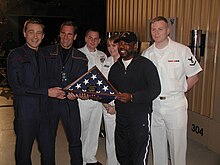
2005 saw the ship in for another routine shipyard overhaul at Newport News Shipyard in Newport News, Virginia. Departing the dock after this yard period, Enterprise ran through a sand bar, causing all eight reactors to shut down, leaving the ship adrift on emergency power for nearly three hours before she was tugged back to her pier at Norfolk Naval Base. It took about three days for the ship's nuclear machinists to clear her condensers of river mud.[74]
In May 2006, Enterprise departed for a six-month deployment, operating in the 6th, 5th and 7th Fleet areas in a world-tour, supporting Operations Iraqi and Enduring Freedom, and visiting ports in Dubai, Hong Kong, and crossing the line. She returned to Norfolk on 18 November 2006.[74]
On 19 December 2007, the carrier returned home after a six-month deployment in the Persian Gulf.[75]
In April 2008, Enterprise entered the Northrop-Grumman Newport News shipyard for a scheduled 18-month Extended Docking Selected Restricted Availability, with a projected completion date of September 2009. As maintenance was performed, costs continued to rise above projections and the completion date repeatedly slid. Enterprise, the oldest active combat vessel in the Navy, was scheduled to be decommissioned as late as 2014. On 6 April 2009, Admiral Gary Roughead, Chief of Naval Operations, said that he was seeking a congressional dispensation to speed up the process to decommission Enterprise. Under this new timetable, the ship would complete one final deployment before being decommissioned in late 2012 or early 2013. This would temporarily reduce the US Navy to having only ten active aircraft carriers through the launch of the Gerald R. Ford in 2015. In October 2009, the House and Senate Armed Services Committees agreed with the recommendation, approving the decommissioning of Enterprise in 2013 after 51 years of service.[14]
2010s
[edit]
In April 2010, the Navy announced that the cost of refurbishing the carrier had risen to $655 million and was scheduled to be completed the same month.[76] On 19 April 2010, Enterprise left the Northrop Grumman shipyard to conduct sea trials in preparation for return to the fleet.[77] The total cost of refurbishing the carrier was $662 million, which was 46% over budget, while the programme of work took eight months longer than scheduled. The Navy said it planned to use the carrier for two six-month deployments before her scheduled 2013 decommissioning date.[78]
On 1 January 2011, the Virginian-Pilot leaked highlights from the final video of a set entitled "XO Movie Night" that was filmed on Enterprise and aired via closed circuit television on select Saturday evenings. The videos, which were not meant for release outside the command, were produced by Captain Owen Honors when he was executive officer (XO) of the ship in the 2006–07 timeframe and included profanity, anti-gay slurs, and sexually suggestive scenes.[79][80]
Captain Honors received public support from Navy personnel,[81] but on 4 January 2011, Admiral John C. Harvey Jr., the commander of the United States Fleet Forces Command in Norfolk removed Honors for demonstrating poor judgment. Captain Dee Mewbourne was appointed as replacement commander.[82] Forty officers and enlisted sailors, including six flag officers, were later disciplined to varying extents over the incident.[83]
The carrier and her strike group deployed on 13 January 2011. Accompanying the carrier on the cruise to the Persian Gulf and Mediterranean were Carrier Air Wing One, guided-missile cruiser Leyte Gulf, and guided-missile destroyers Barry, Bulkeley, and Mason.[84] In February 2011, Enterprise was involved in an incident with Somali pirates, an event that ended in the deaths of four American citizens and two pirates. According to official reports of this incident provided by the navy, two pirates died; with another two dying at an unknown earlier time.[85]
The carrier returned to Norfolk on 15 July 2011. During its deployment, it had participated in operations that captured 75 Somali pirates and its strike group made missile strikes against the Libyan government.[86]

11 March 2012 began the final deployment from Norfolk homeport with Carrier Group Ships USS Vicksburg, Porter, Nitze and James E. Williams and on 9 April 2012, the Navy announced that Enterprise and her group, Carrier Strike Group Twelve, would be assigned to join Abraham Lincoln in the Persian Gulf. The mission was described as routine, not a response to a specific threat. Upon completion of this cruise in fall 2012, Enterprise was officially taken out of service, and was ordered to report back immediately to Norfolk for immediate deactivation, and eventual decommissioning.[87]
In October 2012, Enterprise transited the Suez Canal for the final time.[88] She paid her last foreign port call when she visited Naples, Italy, between 16–21 October, which had been the Big E's first foreign port-of-call fifty years earlier.[89][90]
On 4 November 2012, Enterprise returned to her homeport at Naval Station Norfolk, Virginia, for the last time. While on the journey, the carrier cruised nearly 81,000 miles in a 238-day deployment to the Persian Gulf and her aircraft flew more than 2,000 sorties in support of Operation Enduring Freedom in Afghanistan.[91]
Decommissioning
[edit]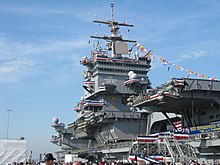
Enterprise was deactivated on 1 December 2012 at Norfolk Naval Station, Virginia. The deactivation of Enterprise resulted in a one-time increase of approximately $857.3 million in depot maintenance costs for the US Navy's operation and maintenance budget for Fiscal Year 2013.[92]
Enterprise was the first nuclear-powered aircraft carrier to be decommissioned.[93] Naval enthusiasts requested that Enterprise be converted into a museum.[94][95] By 2012, this was deemed too expensive to make such an effort practical, in addition to the fact that the ship would need to be partially dismantled anyway to remove the eight reactors safely.[19] A petition was also set up for the next carrier to be named as the ninth USS Enterprise.[96]

At the inactivation ceremony, Secretary of the Navy Ray Mabus announced that the next Gerald R. Ford-class carrier, CVN-80, would be named Enterprise.[97] VIPs present for the ceremony included several former commanding officers, a granddaughter of the ship's sponsor, and a former A-6 pilot, Eugene McDaniel, who had been shot down and captured in North Vietnam and was returning to the ship for the first time since the day he was shot down.[citation needed]
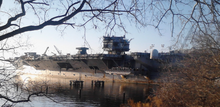
On 8 February 2013, the United States Department of Defense announced that a number of nuclear projects would have to be postponed until the upcoming budget sequestration issue was resolved. These include the planned de-fueling of Enterprise as well as mid-life overhauls (including nuclear refueling) for two Nimitz-class ships.[98] The contract for de-fueling Enterprise was eventually awarded to Huntington Ingalls Industries in June 2013.[99]
In October 2014, Newport News Shipbuilding announced that one of Enterprise's anchors, removed from the ship during deactivation, had been transferred to the Nimitz-class Abraham Lincoln during her RCOH.[100] In early 2017, it was announced that steel from CVN-65 will be recycled and used to construct CVN-80.[101] Over 35,000 pounds of steel has been removed from CVN-65 and repurposed into CVN-80.[102] The crew of the ship's final deployment built a time capsule constructed from her steel and wood to preserve the carrier's history for CVN-80.[103]
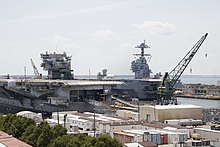
The final reactor was de-fueled in December 2016,[16] with Enterprise officially decommissioned on 3 February 2017.[104] The same day, the ship was stricken from the Naval Vessel Registry (NVR). According to Navy Sea Systems Command, the recycling of Enterprise was delayed by the Navy until further information on "more technically executable, environmentally responsible" approaches to disposing of the aircraft carrier are available.[105] On 10 April 2018, Newport News Shipbuilding announced that Enterprise's inactivation process has been completed. Ex-Enterprise was stored at Hampton Roads while disposal plans were determined by the Navy.[106]
The final disposal plan for Enterprise will be a long and complicated process. The carrier had eight reactors and numerous compartments contaminated by radiation and therefore could not be used as a target ship in a SINKEX or live-fire training sinking exercise. The Navy set up a new office to organize the disposal of Enterprise and the coming retirement of the Nimitz-class carriers. Ultimately, it was decided to use a commercial facility to break the ship up, with scrapping to begin in 2025. The process is anticipated to take five years, with the Enterprise to be gone completely by 2030.[107]
Awards and decorations
[edit]| Joint Meritorious Unit Award | Navy Unit Commendation with three stars | Meritorious Unit Commendation with six stars |
| Navy E Ribbon with three Battle "E" devices | Navy Expeditionary Medal with one star | National Defense Service Medal with two stars |
| Armed Forces Expeditionary Medal with nine stars | Vietnam Service Medal with ten stars | Global War on Terrorism Expeditionary Medal with four stars |
| Armed Forces Service Medal with one star | Humanitarian Service Medal with one star | Sea Service Deployment Ribbon with twelve stars |
| Republic of Vietnam Meritorious Unit Citation (Gallantry Cross) | Republic of Vietnam Civil Actions Unit Citation | Vietnam Campaign Medal |
In popular culture
[edit]In the 1986 science-fiction film Star Trek IV: The Voyage Home, Pavel Chekov and Uhura infiltrate the Enterprise. Scenes set on the Enterprise were actually filmed aboard the USS Ranger (CV-61) since the actual Enterprise was at sea during filming.[108]
The Enterprise is a setting in the film Top Gun, also released in 1986. Shots of the main characters' F-14s on the flight deck and general flight-ops scenes were filmed on both the actual Enterprise and the USS Carl Vinson (CVN-70), with the latter being used after the Enterprise ran aground at Cortes Bank. The USS Ranger again substituted for the Enterprise for interior shots.[109]
The Enterprise is at the center of The Raft, a refugee flotilla, in the 1992 novel Snow Crash.
See also
[edit]- Aerial warfare
- Air supremacy
- Carrier battle group
- Carrier strike group
- Carrier Strike Group 12
- List of aircraft carriers
- List of aircraft carriers of the United States Navy
- List of longest ships
- List of ships of the United States Navy named Enterprise
- Russian aircraft carrier Admiral Kuznetsov
References
[edit]Notes
[edit]Citations
[edit]- ^ Jane's American fighting ships of the 20th century, New York: Mallard Press, 1991, ISBN 0-7924-5626-2
- ^ USS Enterprise: The Legend, US: Navy, archived from the original on 1 March 2013
- ^ a b c Naval Vessel Register - Enterprise (CVN-65), US: Navy
- ^ a b c King, Jared M.; USS Enterprise Public Affairs (1 December 2010). "Navy's second oldest commissioned ship turns 49". Military News. Retrieved 7 July 2022.
- ^ a b "USS Enterprise Nuclear-powered aircraft carrier", Military today, archived from the original on 23 July 2011
- ^ "Evolution of the Aircraft Carrier". navylive.dodlive.mil. 12 April 2015. Retrieved 29 August 2018.
- ^ a b "USS Enterprise". naval-technology.com. Retrieved 3 April 2018.
- ^ Cracknell, p. 56: "The main armor carried on Enterprise is the heavy armoured flight deck. This was to prove a significant factor in the catastrophic fire and explosions that occurred on Enterprise's flight deck in 1969. The US Navy learned its lesson the hard way during World War II when all its carriers had only armoured hangar decks. All attack carriers built since the Midway class have had armored flight decks."
- ^ "Enterprise class nuclear powered attack aircraft carriers", Haze gray
- ^ a b "Facts & Stats", Enterprise, US: Navy, archived from the original on 2 May 2012, retrieved 13 April 2012
- ^ a b Sharpe, Richard, ed. (2000). Jane's Fighting Ships 2000–2001. Coulsdon, Surrey, UK: Jane's Information Group. p. 798. ISBN 0-7106-2018-7.
- ^ http://www.nvr.navy.mil/SHIPDETAILS/SHIPSDETAIL_CVN_65.HTML
- ^ US Navy. "Welcome to Navy Forces Online Public Sites". Archived from the original on 27 July 2013. Retrieved 18 July 2013.
- ^ a b House and Senate Armed Services Committees agree FY 2010 Navy shipbuilding authorization, Defpro, 10 October 2009, archived from the original on 17 July 2011
- ^ "FY13 Projected Ship Inactivation Schedule". Bureau of Naval Personnel. March 2012. Retrieved 13 October 2014.
- ^ a b Vergakis, Brock. "Navy to give final farewell to aircraft carrier USS Enterprise". Archived from the original on 25 January 2017.
- ^ Brad Lendon. "Carrier turns donor: USS Enterprise gives anchor to USS Lincoln". CNN.com. Retrieved 3 October 2014.
- ^ "USS Enterprise (CVN 65) Official Web Site". Public.navy.mil. Archived from the original on 1 March 2013. Retrieved 20 April 2013.
- ^ a b "World's First Nuclear-powered Aircraft Carrier, the Big E, makes final voyage". foxnews.com, 10 March 2012.
- ^
 This article includes information collected from the Naval Vessel Register, which, as a U.S. government publication, is in the public domain. The entry can be found here.
This article includes information collected from the Naval Vessel Register, which, as a U.S. government publication, is in the public domain. The entry can be found here.
- ^ USS Enterprise (CVN-65) – Official Facebook Page, Navy, 1 December 2012, retrieved 1 December 2012
- ^ USS Enterprise Public Affairs. "Enterprise, Navy's First Nuclear-Powered Aircraft Carrier, Inactivated". Navy.mil. Retrieved 8 December 2012.
- ^ a b c d Friedman 1983, p. 313
- ^ "Speed Thrills III – Max speed of nuclear-powered aircraft carriers". Navweaps.com. 29 April 1999. Retrieved 20 April 2013.
- ^ Weber, Bill (20 June 2007). "The First and the Finest: Aboard the USS Enterprise". NASCAR.com. Archived from the original on 28 June 2011. Retrieved 14 July 2007.
- ^ Jane's American fighting ships of the 20th century, p. 89. New York: Mallard Press, 1991. ISBN 0-7924-5626-2.
- ^ Gardiner & Chumbley 1995, p. 572
- ^ Cracknell 1972, p. 56
- ^ Polmar 1981, p. 53
- ^ Blackman 1971, p. 437
- ^ Cullen, Tony. Encyclopedia of World Sea Power, p. 68. ISBN 0-517-65342-7.
- ^ 061031-N-0119G-115 Stbd side, RAM aft (image), US: OSD, archived from the original (JPEG) on 21 July 2011
- ^ Forward Port side, RAM launcher (image), US: OSD, archived from the original (JPEG) on 7 August 2008.
- ^ Thor (15 January 2011). "Science, Natural Phenomena & Medicine: AN/SPS-32". Science-naturalphenomena.blogspot.com. Archived from the original on 20 February 2020. Retrieved 20 April 2013.
- ^ Dreadnaughtz (username) (25 December 2022). "USS Enterprise(1960)". Naval Encyclopedia. Retrieved 9 October 2023.
- ^ Battle 360, "The Empire's Last Stand." Dir. Tony Long. History Channel. 2 May 2008 (2 May 2008)
- ^ a b Cracknell 1972, p. 59
- ^ Video on YouTube Navy Decommissions "The Big E"
- ^ a b c "Enterprise VIII (CVAN-65): 1961-1965". Dictionary of American Naval Fighting Ships. Navy Department, Naval History and Heritage Command. Retrieved 13 January 2017.
- ^ a b Cracknell 1972, p. 60
- ^ Clift, A. Denis (October 2022). "Task Force 135 On Course for Cuba". US Naval institute. Retrieved 9 October 2023.
- ^ "United States Naval Aviation 1910–1995". Naval History & Heritage Command. p. 250. Archived from the original (The Sixth Decade) on 2 August 2013.
- ^ "Portaerei Enterprise CVN 65 Storia". Digilander.libero.it. Retrieved 20 April 2013.
- ^ Cracknell 1972, p. 65
- ^ Holloway, James III (2007). "Week of December 3". The United states of America, Vietnam War Commemoration. Retrieved 10 October 2023.
- ^ a b "Enterprise Command History", History, U.S. Navy, 1966, 1–2
- ^ Cagle, Malcom W. (May 1972). "Task force 77 in action off Vietnam". US Naval institute. Retrieved 10 October 2023.
- ^ "Explosion rocks USS Enterprise", History.com, archived from the original on 7 March 2010
- ^ Military video, archived from the original on 28 September 2007
- ^ Cox, Samuel J (31 January 2019). "H-025-2 USS Enterprise Fire 1969". Naval History and Heritage Command. Retrieved 9 October 2023.
- ^ a b c d e f Grossnick, Roy A.; Evans, Mark (2016). United States Naval Aviation, 1910-2010 (PDF). Naval History and Heritage Command. ISBN 9780945274759.
 This article incorporates text from this source, which is in the public domain.
This article incorporates text from this source, which is in the public domain.
- ^ "Cold war games", Bharat Rakshak, archived from the original on 9 June 2011
- ^ a b "Chapter 5: The Final Curtain, 1973 – 1975". history.navy.mil. 2000. Retrieved 24 July 2007.
 This article incorporates text from this source, which is in the public domain.
This article incorporates text from this source, which is in the public domain.
- ^ Tobin, Thomas (1978). USAF Southeast Asia Monograph Series Volume IV Monograph 6: Last Flight from Saigon. US Government Printing Office. pp. 98–9. ISBN 978-1-4102-0571-1.
 This article incorporates text from this source, which is in the public domain.
This article incorporates text from this source, which is in the public domain.
- ^ "Navy News" (PDF). Navy News. Australian Gov. 5 November 1976. Retrieved 21 November 2018.
- ^ "Off Course", Time, 9 May 1983, archived from the original on 22 January 2011
- ^ History, US: Navy, archived from the original on 7 December 2010
- ^ "Former commander", CPF, US Navy, archived from the original on 13 November 2007
- ^ Bunting, Glenn F. (26 February 1986). "Commanding Carrier: Just One Mistake Can Torpedo a Navy Career". Los Angeles Times. Retrieved 13 October 2014.
- ^ McClusky (1986), Command History
- ^ Enterprise Command History, 1986
- ^ Peniston, Bradley (2006). No Higher Honor: Saving the USS Samuel B. Roberts in the Persian Gulf. Annapolis, Maryland: Naval Institute Press. pp. 181–87. ISBN 1-59114-661-5. Archived from the original on 18 January 2009.
- ^ "USS Enterprise (CVN-65): 1994 Command History" (PDF). Navy.mil. 6 March 1995. Retrieved 19 July 2022.
- ^ Cenciotti, David (24 October 2018). "Video Shows Tragic Collision of EA-6B Prowler with S-3B Viking Aboard USS Enterprise in 1998". The Aviationist. Retrieved 24 December 2024.
- ^ "Navy Planes Crash on Carrier's Flight Deck". Archived from the original on 20 April 2016. Retrieved 24 December 2024.
- ^ Writer, SONJA BARISIC Associated Press. "Search ends for missing three in carrier crash". Cape Cod Times. Retrieved 24 December 2024.
- ^ Press, Associated (9 November 1998). "3 MISSING FLIERS PRESUMED DEAD IN NAVY CRASH". The Washington Post. Retrieved 24 December 2024.
- ^ "Hootie and the Blowfish perform for the crew members of the USS Enterprise". U.S. Department of Defense. Retrieved 19 October 2019.
- ^ "JTFEX Exercise Concluded". historycentral.com. Retrieved 18 December 2020.
- ^ "Deutsches U-Boot fordert US-Marine heraus" (in German). t-online. 6 January 2013. Retrieved 18 December 2020.
- ^ Reynolds, Brian G. "Big E Honors Victims of 9/11 Attacks".
- ^ "The Legend of Enterprise". US Navy. Archived from the original on 1 March 2013. Retrieved 9 April 2013.
- ^ "Bush remembers Pearl Harbor aboard USS Enterprise". CNN.com. Archived from the original on 2 December 2010. Retrieved 20 February 2013.
- ^ a b "Navy May Dismantle Former Nuclear-Powered Aircraft Carrier Enterprise at Commercial Yard". USNI News. 23 August 2022. Retrieved 25 January 2023.
- ^ "USS Enterprise Returns Home", Charlottesville newplex TV, archived from the original on 2 April 2009, retrieved 10 April 2008
- ^ Frost, Peter, "USS Enterprise Delayed Again; Cost of Maintenance Balloons 44.5 Percent", Newport News Daily Press, 1 April 2010.
- ^ Enterprise Departs for Sea Trials, ASD news, archived from the original on 21 April 2010, retrieved 19 April 2010
- ^ Frost, Peter. "USS Enterprise: After Spending 2 Years in Newport News, Enterprise Returned to Navy" . Newport News Daily Press, 20 April 2010.
- ^ "Raunchy videos starring Enterprise skipper come to light". Hampton roads. December 2010. Retrieved 2 January 2011.
- ^ "Navy Captain Owen Honors 'to lose post for lewd videos'". BBC News. 4 January 2011. Archived from the original on 5 January 2011. Retrieved 4 January 2011.
- ^ "Navy to relieve officer during inquiry over lewd videos". NBC News. 3 January 2011. Retrieved 3 January 2011.
- ^ "USFF Relieves USS Enterprise Commanding Officer". US: Navy – Fleet Forces Command Public Affairs. Retrieved 4 January 2011.
- ^ Military Times, "40 faulted in Enterprise video investigation", 3 March 2011; Retrieved 4 March 2011.
- ^ Lessig, Hugh, "Enterprise Carrier Group To Deploy Next Week", Newport News Daily Press, 8 January 2011.
- ^ "Four American hostages killed by Somali pirates", NBC News, 22 February 2011
- ^ Wilson, Todd Allen, "USS Enterprise Returns To Norfolk", Newport News Daily Press, 16 July 2011.
- ^ US Navy deploys 2nd aircraft carrier to Gulf, Yahoo! news, 9 April 2012, retrieved 9 April 2012
- ^ Reynolds, Brian G. (15 October 2012). "Enterprise Transits The Suez Canal for the Final Time". NNS121015-04. Enterprise Carrier Strike Group Public Affairs. Retrieved 15 October 2012.
- ^ Smith, Steve (19 October 2012). "Enterprise Arrives in Naples, Italy For Final Foreign Port Visit". NNS121019-01. Enterprise Strike Group Public Affairs. Retrieved 21 October 2012.
- ^ Reynolds, Brian G. (22 November 2012). "Enterprise Visits Naples for the Last Time". NNS121022-05. Enterprise Strike Group Public Affairs. Retrieved 5 November 2012.
- ^ Enterprise ends 51-year career at sea, Military, 5 November 2012
- ^ Under Secretary of Defense (Comptroller)/chief financial officer (February 2012). "Operation and Maintenance Overview: Fiscal Year 2012 Budget Estimates operation" (PDF). Washington, D.C., US: Department of Defense. p. Navy – 13. Archived from the original (PDF) on 3 July 2012. Retrieved 4 June 2012.
- ^ Erwing, Phillip (21 September 2010). "Big E preps for final combat deployment". Navy Times. Retrieved 22 September 2010.
- ^ "CVN65", ePetitions, archived from the original on 21 August 2009
- ^ "Signatures for A Petition to name the next United States Navy nuclear powered aircraft carrier the USS Enterprise". ePetitions. Archived from the original on 7 February 2012. Retrieved 18 June 2011.
- ^ "News Release – Navy's Next Ford-Class Aircraft Carrier to be Named Enterprise". U.S. Navy. 1 December 2012. Retrieved 1 December 2012.
- ^ "Navy delays overhaul of aircraft carrier USS Abraham Lincoln, citing budget concerns". Washington Post. Associated Press. 8 February 2013. Archived from the original on 12 April 2013. Retrieved 10 February 2013. and "Lack of Funding Affects USS Lincoln Refueling and Complex Overhaul". NNS130208-17. Defense Media Activity – Navy. 8 February 2013. Archived from the original on 13 December 2014. Retrieved 10 February 2013.
- ^ "HII Awarded $745 Million Contract to Inactivate USS Enterprise (CVN 65)". Huntonton Ingalls Industries. 28 June 2013. Retrieved 12 December 2014.
- ^ Carrier turns donor: USS Enterprise gives anchor to USS Lincoln, CNN, 3 October 2014
- ^ Corillo, Todd (3 February 2017). "World's first nuclear powered aircraft carrier officially decommissioned". WKTR. Retrieved 3 February 2017.
- ^ Naval News Staff (28 August 2022). "HII Lays Keel of Future USS Enterprise (CVN 80) Aircraft Carrier". Naval News. Retrieved 29 August 2022.
- ^ Knight, Matt (30 November 2012). "Sailors aboard the USS Enterprise prepare a time capsule". WTKR. Retrieved 8 July 2022.
- ^ Johnson, Kevin. "Navy Decommissions "The Big E"". navy.mil. United States Navy. Retrieved 3 February 2017.
- ^ Mabeus, Courtney. "Navy delays recycling of decommissioned USS Enterprise, which will be put in storage".
- ^ Mitchell, Becca (10 April 2018). "Newport News Shipbuilding says inactivation of former USS Enterprise is complete". WKTR. Retrieved 15 December 2023.
- ^ Katz, Justin (15 November 2023). "Uncharted waters: Navy navigating first-ever dismantling of nuclear-powered carrier". BreakingDefense.com. Breaking Media, Inc. Retrieved 15 December 2023.
- ^ Okuda, Michael; Okuda, Denise; Mirek, Debbie (2016). The Star Trek Encyclopedia. Vol. 1 (4 ed.). becker&mayer. p. 245. ISBN 9780062371331.
- ^ "Aircraft carrier USS Ranger, used in movies 'Top Gun' and 'Star Trek IV', heading for Texas scrap yard". Q13 Fox. Associated Press. 5 March 2015. Retrieved 17 August 2021.
Bibliography
[edit]- Blackman, Raymond V. B., ed. (1971), Jane's Fighting Ships 1971–72, London: Jane's Yearbooks, ISBN 0-354-00096-9
- Cracknell, W. H. (1972), Warship Profile 15: USS Enterprise (CVAN 65) Nuclear Attack Carrier, Windsor, UK: Profile Publications
- Friedman, Norman (1983), U.S. Aircraft Carriers: An Illustrated Design History, Annapolis, Maryland, USA: Naval Institute Press, ISBN 0-87021-739-9
- Gardiner, Robert; Chumbley, Stephen, eds. (1995), Conway's All the World's Fighting Ships 1947–1995, Annapolis, Maryland, USA: Naval Institute Press, ISBN 1-55750-132-7
- Polmar, Norman (1981), The Ships and Aircraft of the U.S. Fleet (Twelfth ed.), London: Arms and Armour Press, ISBN 0-85368-397-2
- United States Naval Aviation, 1910–1995, Naval Historical Center
- USS Enterprise (CVN 65) public affairs office
 This article incorporates text from the public domain Dictionary of American Naval Fighting Ships.
This article incorporates text from the public domain Dictionary of American Naval Fighting Ships.
External links
[edit]| External media | |
|---|---|
| Images | |
| Video | |
![]() Media related to USS Enterprise (CVN-65) at Wikimedia Commons
Media related to USS Enterprise (CVN-65) at Wikimedia Commons
- "Disposal of Decommissioned, Defueled Ex-Enterprise (CVN 65) and Its Associated Naval Reactor Plants EIS/OEIS". United States Navy.
- "Official USS Enterprise website". Archived from the original on 17 January 2015.
- "Enterprise (CVN 65) (ex-CVAN 65)". Naval Vessel Register.
- "USS Enterprise (CVN 65) Story Archive". Navy News Service. Archived from the original on 16 May 2013. Retrieved 2 December 2011.
- "Official Big E Reactor and Engineering Memories". King Paul. Archived from the original on 27 April 2015. Retrieved 2 April 2015.
- "Enterprise (CVN-65)". Dictionary of American Naval Fighting Ships. Navy Department, Naval History and Heritage Command.
- "USS Enterprise CVAN/CVN-65 Association".
- "USS Enterprise (CVN 65)". Navy site.
- "USS Enterprise CVN-65". US Carriers.
- USS Enterprise (CVAN-65/CVN-65) command histories from Naval History & Heritage Command
- "Enterprise (CVN-65) Commanding Officers". Dictionary of American Naval Fighting Ships. Navy Department, Naval History and Heritage Command.
- Aircraft carriers of the United States Navy
- 1960 ships
- Nuclear-powered ships of the United States Navy
- Cold War aircraft carriers of the United States
- Vietnam War aircraft carriers of the United States
- Ships built in Newport News, Virginia
- Afghanistan War ships of the United States
- Nuclear-powered aircraft carriers
- Ships of the Indo-Pakistani wars
- Indo-Pakistani war of 1971
- Carl Vinson

